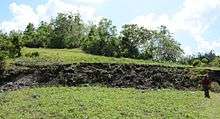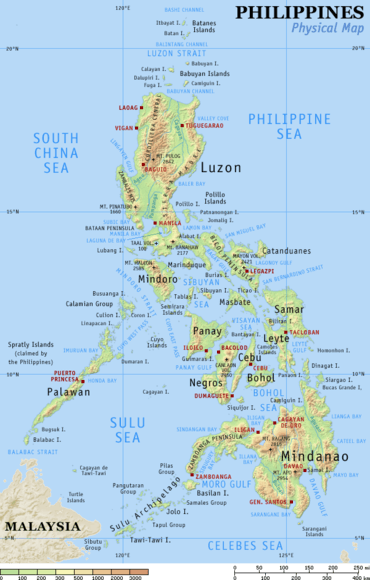Bohol Fault System
Bohol Fault System, or also known as (BFS), is a reverse fault system in Bohol province, Philippines. This fault system contains two segments: the newly found North Bohol Fault following the 2013 Bohol earthquake,[3] and the East Bohol Fault.
| Bohol Fault System | |
|---|---|
 Surface rupture of the North Bohol Fault during the 2013 Bohol earthquake at Inabanga, Bohol | |
| Etymology | Bohol |
| Named by | Philippine Institute of Volcanology and Seismology |
| Year defined | 2013 |
| Country | Philippines |
| Region | Central Visayas |
| State | Bohol |
| Cities | North; Loon, Calape, Inabanga, Tubigon, Buenavista, Clarin, Sagbayan, Getafe, Trinidad East; Loboc, Bilar, Batuan, Carmen |
| Characteristics | |
| Range | Inabanga & Clarin |
| Segments | North Bohol Fault, East Bohol Fault |
| Depth | 30 km (19 mi) |
| Tectonics | |
| Plate | Philippine Sea Plate and Sunda Plate |
| Status | Active |
| Earthquakes | 1981, 1990, 2013 |
| Type | Reverse fault |
| Movement | Dextral |
| Age | Gelasian |
| Orogeny | Mindanao-Surigao-Davao Orogeny |
| Volcanic arc/belt | Bohol Corridor |
The North Bohol fault is located in Inabanga and near Clarin, while the East Bohol fault passes through the SW part of Bohol at Tagbilaran and goes eastwards.
Bohol fault segments
North Bohol fault
North Bohol fault or Inabanga fault is a reverse fault located at Anonang, Inabanga which was found on 15 October 2013 during the Bohol earthquake. Based on Phivolcs, a new fault occurs only once in a century. The North Bohol fault, shaped as a hanging wall and also known as the "Great Wall of Bohol", became one of the tourist attractions in Bohol province.[4][5]
Bohol earthquake
The 2013 Bohol earthquake was a deadly event which happened on 15 October, striking the provinces of Bohol, Cebu, Negros Oriental, Masbate and Leyte. Teresito Bacolcol discovered the new fault in the area of Inabanga and Clarin.
See also
References
- "M 6.0 - Bohol, Philippines". United States Geological Survey. Retrieved March 14, 2018.
- "M 6.8 - Bohol, Philippines". United States Geological Survey. Retrieved March 14, 2018.,
- Camille Diola (October 23, 2013). "Phivolcs discovers new fault system in Bohol quake". philstar.com. STAR Group of Publications. Retrieved 8 August 2016.
- "North Bohol fault becomes tourist attraction". news.abs-cbn.com. ABS-CBN Corporation. October 28, 2013. Retrieved 8 August 2016.
- "Post-earthquake Bohol: Silver lining after the disaster". Department of Environment and Natural Resources. Archived from the original on 25 January 2017.
- Live Science, Becky Oskin (15 October 2013). "What Caused the Deadly Philippines Earthquake?". Archived from the original on 15 October 2013.CS1 maint: ref=harv (link)
- Bohol Chronicle, Chito M. Visarra (24 April 2016). "PHIVOLCS warns on quake due to East fault". Archived from the original on 29 April 2016.CS1 maint: ref=harv (link)
.svg.png)
